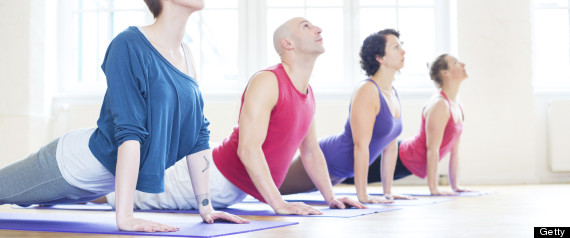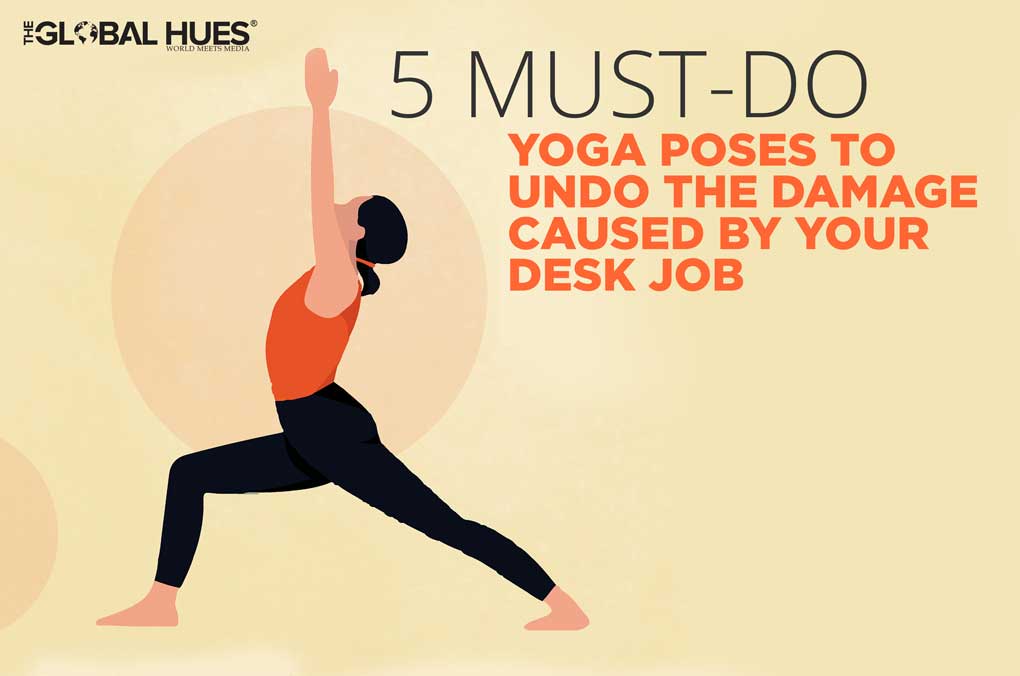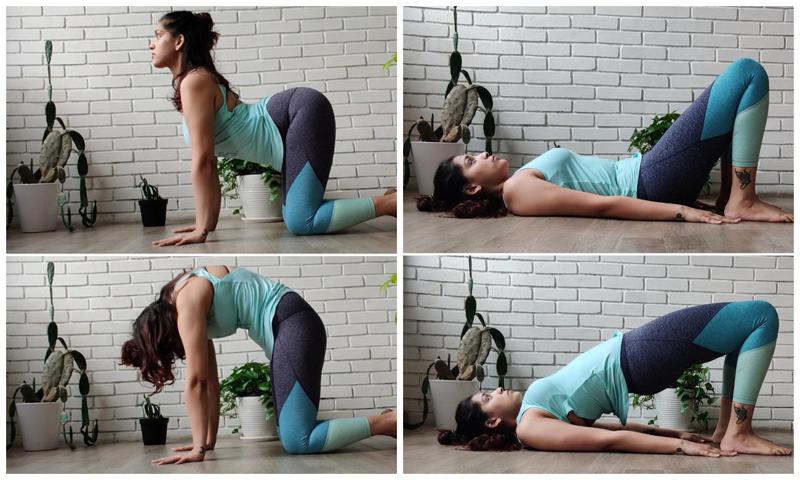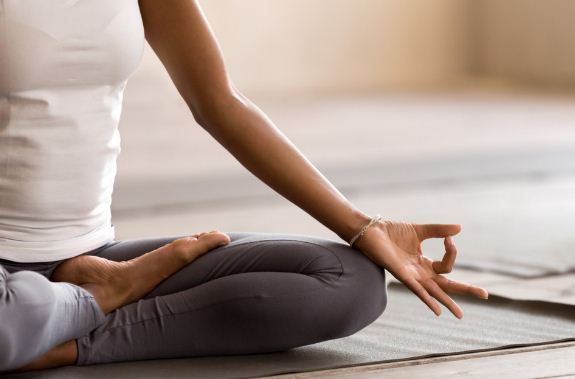Yoga Poses To Undo The Damage Of Your Desk Job, it is crucial to incorporate movement into your routine to counteract the negative effects of a sedentary lifestyle. Engaging in physical activity helps improve blood circulation, reduce muscle stiffness, and enhance overall flexibility. Regular movement can also prevent posture-related problems, decrease the risk of cardiovascular diseases, and boost mental well-being. It is recommended to take short breaks every hour to stretch or walk around. You can also perform simple exercises such as neck rolls, shoulder stretches, and leg lifts. By prioritizing movement after a desk job, you can promote a healthier body and mind.
Benefits of incorporating yoga poses

Incorporating yoga poses into your routine can offer numerous benefits for your body and mind. Yoga helps improve flexibility, strength, and balance, while also reducing stress and anxiety. It can enhance posture, alleviate muscle tension, and increase body awareness. By regularly practicing yoga poses, such as the Mountain Pose, Cat-Cow Stretch, Seated Forward Fold, and Crescent Lunge, you can undo the damage caused by sitting at a desk all day. These poses stretch and realign the body, targeting areas that suffer from prolonged sitting. By incorporating yoga into your daily routine, you can experience improved physical well-being and overall vitality.
Importance of stretching and realigning the body
Stretching and realigning the body is crucial for maintaining overall health and well-being. It helps release tension in the muscles, improves flexibility, and enhances posture. By incorporating regular stretching into your routine, you can prevent muscle imbalances, reduce the risk of injury, and improve your body’s range of motion. Stretching also increases blood flow to the muscles, providing them with the necessary nutrients and oxygen. Whether it’s through yoga poses or other stretching exercises, taking the time to stretch and realign your body can have a significant impact on your physical health and overall quality of life.
Mountain Pose

Mountain Pose, also known as Tadasana, is a foundational yoga pose that helps improve posture, balance, and body awareness. To practice Mountain Pose, start by standing tall with your feet hip-width apart, arms relaxed at your sides. Engage your core, lengthen your spine, and roll your shoulders back and down. Distribute your weight evenly between both feet and feel grounded. Take deep breaths, allowing your body to relax and find alignment. Hold the pose for a few breaths or as long as it feels comfortable. Mountain Pose can be practiced on its own or as a starting point for other standing poses. It’s a simple yet powerful pose for grounding and centering the body.
Instructions and benefits of Mountain Pose
To perform Mountain Pose, stand tall with feet hip-width apart, arms relaxed at your sides. Engage your core, lengthen your spine, and roll your shoulders back and down. Distribute your weight evenly between both feet. Take deep breaths and relax your body. This pose improves posture, balance, and body awareness. It also helps in grounding and centering the body. Mountain Pose can be practiced alone or as a starting point for other standing poses.
Variations and modifications for different fitness levels
Variations and modifications for different fitness levels are crucial in yoga practice to ensure that individuals of all levels can participate and benefit from the poses. Here are some options to consider:
- For beginners: If you are new to yoga or have limited flexibility, you can modify Mountain Pose by placing your hands on your hips or using a wall for support. This will help you find balance and stability.
- For intermediate practitioners: To challenge yourself, you can try extending your arms overhead in Mountain Pose, reaching towards the sky. This will engage your core and increase the stretch in your spine.
- For advanced yogis: For a more intense variation of Mountain Pose, you can try adding a balancing component by lifting one leg off the ground and bringing it into a tree pose. This will further improve your balance and strengthen your legs.
Remember to listen to your body and only do what feels comfortable for you. Stay consistent in your practice, and over time, you may find that you are ready for more advanced variations.
Cat-Cow Stretch

Cat-Cow Stretch
The Cat-Cow Stretch is a simple and effective yoga pose that helps to stretch and mobilize the spine. Start on all fours with your hands beneath your shoulders and knees beneath your hips. Inhale as you arch your back, lifting your chest and tailbone towards the ceiling, creating the Cow pose. Exhale as you round your back, tucking your chin towards your chest and pressing through your hands and knees, creating the Cat pose. Repeat this flowing movement, synchronizing your breath with the movement. The Cat-Cow Stretch helps to relieve tension in the back, improve spinal flexibility, and promote better posture.
How to perform Cat-Cow Stretch

To perform the Cat-Cow Stretch, start on all fours with your hands beneath your shoulders and knees beneath your hips. Inhale as you arch your back, lifting your chest and tailbone towards the ceiling, creating the Cow pose. Exhale as you round your back, tucking your chin towards your chest and pressing through your hands and knees, creating the Cat pose. Repeat this flowing movement, synchronizing your breath with the movement. The Cat-Cow Stretch helps to relieve tension in the back, improve spinal flexibility, and promote better posture.
Benefits for relieving back tension and improving posture
The Cat-Cow Stretch is highly effective in relieving back tension and improving posture. By flowing between the arching and rounding of the back, this stretch helps to release tightness in the back muscles, increase flexibility in the spine, and promote better alignment. With regular practice, the Cat-Cow Stretch can help alleviate pain and discomfort caused by sitting for extended periods, making it an essential exercise for undoing the damage of a desk job.
Seated Forward Fold
To perform Seated Forward Fold, start by sitting on the floor with your legs extended in front of you. Take a deep breath in, lengthen your spine, and on the exhale, hinge forward from your hips, reaching for your feet or ankles. As you fold forward, focus on keeping your spine long and avoid rounding your back. Hold the stretch for 30 seconds to one minute, breathing deeply.
Seated Forward Fold stretches the spine, hamstrings, and calves, while also releasing tension in the lower back. It can help improve flexibility, relieve stress and anxiety, and promote a sense of calm. Remember to listen to your body and only go as far as feels comfortable.
Steps to do Seated Forward Fold

To perform Seated Forward Fold, start by sitting on the floor with your legs extended in front of you. Take a deep breath in, lengthen your spine, and on the exhale, hinge forward from your hips, reaching for your feet or ankles. As you fold forward, focus on keeping your spine long and avoid rounding your back. Hold the stretch for 30 seconds to one minute, breathing deeply. Seated Forward Fold stretches the spine, hamstrings, and calves, while also releasing tension in the lower back. It can help improve flexibility, relieve stress and anxiety, and promote a sense of calm. Remember to listen to your body and only go as far as feels comfortable.
Stretching the spine and relieving lower back pain

To stretch the spine and relieve lower back pain, you can try the Seated Forward Fold yoga pose. Begin by sitting on the floor with your legs extended in front of you. Take a deep breath in, lengthen your spine, and on the exhale, hinge forward from your hips, reaching for your feet or ankles. As you fold forward, keep your spine long and avoid rounding your back. Hold the stretch for 30 seconds to one minute, breathing deeply. Not only does Seated Forward Fold stretch the spine, hamstrings, and calves, but it also releases tension in the lower back. Incorporating this pose into your routine can improve flexibility, relieve stress and anxiety, and promote a sense of calm. Remember to listen to your body and only go as far as feels comfortable.
Crescent Lunge

To perform Crescent Lunge, start in a low lunge position with your right foot forward, knee bent at a 90-degree angle, and left leg extended back. Square your hips forward and engage your core. Inhale as you raise your arms overhead, reaching towards the sky. Keep your shoulders relaxed and gaze forward. Hold the pose for a few breaths, then switch sides. Crescent Lunge stretches the hip flexors, strengthens the legs, and improves core stability. It also helps to improve balance and concentration. Remember to keep proper alignment and listen to your body for any discomfort or strain.
Crescent Lunge for hip flexors and core strength

Crescent Lunge is a powerful yoga pose that targets the hip flexors and strengthens the core. To perform Crescent Lunge, start in a low lunge position with your right foot forward, knee bent at a 90-degree angle, and left leg extended back. Square your hips forward and engage your core. Inhale as you raise your arms overhead, reaching towards the sky. Hold the pose for a few breaths, then switch sides. This pose helps to stretch and loosen tight hip flexors, while also building stability and strength in the core muscles. Remember to maintain proper alignment and listen to your body for any discomfort or strain.
Guidelines for proper alignment and variations

To ensure proper alignment in Crescent Lunge, start by aligning your right knee directly above your right ankle and keeping your back leg extended and engaged. As you raise your arms overhead, focus on lengthening your spine and engaging your core for stability. Variations include using blocks for support under your hands or incorporating a gentle twist by bringing one hand to the outside of the front knee. Experiment with these variations to find what feels comfortable and effective for your body. Remember, proper alignment is key to getting the most out of this pose and preventing injury.
Conclusion of Yoga Poses To Undo The Damage Of Your Desk Job

Incorporating yoga poses into your daily routine is crucial for undoing the damage caused by a desk job. Mountain Pose helps to improve posture and alignment, while Cat-Cow Stretch relieves tension in the back. Seated Forward Fold stretches the spine and alleviates lower back pain. Crescent Lunge targets the hip flexors and builds core strength. Remember to focus on proper alignment and explore variations that work for you. By regularly practicing these poses, you can counteract the negative effects of sitting at a desk and promote overall health and well-being. For more desk job recovery poses and routines, refer to additional resources available. Make it a priority to prioritize your body and mind, and incorporate yoga into your daily life.
Reiterate the importance of incorporating yoga

Reiterate the importance of incorporating yoga
Incorporating yoga into your daily routine is crucial for undoing the damage caused by a desk job. It helps to improve posture, alleviate back pain, stretch the spine, and target specific areas like the hip flexors and core muscles. By regularly practicing yoga poses, you can counteract the negative effects of sitting at a desk and promote overall health and well-being. So make it a priority to prioritize your body and mind, and incorporate yoga into your daily life.
Additional resources for desk job recovery poses and routines
- Yoga Apps: Download apps like “Yoga Studio” or “Down Dog” for guided yoga routines specifically designed for desk job recovery.
- Online Yoga Classes: Join online platforms like “Yoga with Adriene” or “Gaia” to access a variety of yoga classes that target desk job issues.
- Desk Stretches: Search for YouTube videos or articles that demonstrate simple desk stretches you can do throughout the day to relieve tension and improve posture.
- Yoga Props: Invest in props like yoga blocks or resistance bands to enhance your yoga practice and deepen stretches.
- Yoga Blogs and Websites: Explore websites and blogs dedicated to yoga, such as “Yoga Journal” or “DoYouYoga,” for articles and videos on desk job recovery poses and routines.
Remember to prioritize your well-being and make use of these resources to incorporate yoga into your daily routine and undo the damage caused by a desk job.
For More Blogs visit Aerns

